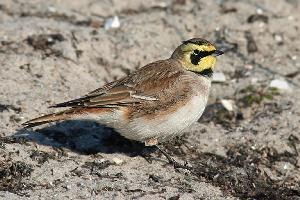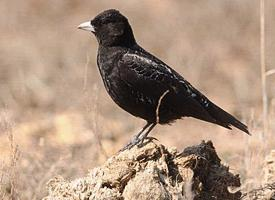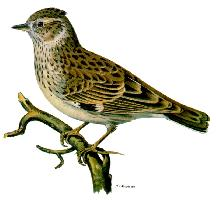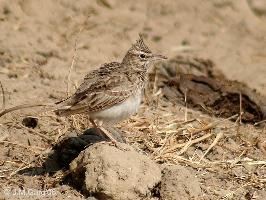
Description de l'animal
The Horned Lark, scientifically named Eremophila alpestris, is a distinctive and fascinating bird species known for its unique features and wide distribution. This small, yet striking, bird is part of the Alaudidae family, which encompasses various lark species. One of the most captivating aspects of the Horned Lark is its appearance, marked by a set of black feather tufts on its head that resemble horns, a characteristic from which its name is derived.Adult Horned Larks exhibit a color palette that blends seamlessly with their natural habitats. They have a brownish-grey back and wings, which provide excellent camouflage against the earthy tones of open landscapes. The underparts are pale, often a soft yellow or white, creating a sharp contrast. A distinct feature is the black, mask-like facial pattern and the black and yellow markings above the eyes, which add to their unique appearance. Males and females are similar in appearance, though males tend to have more pronounced markings.
These birds are found across a broad range, spanning North America, Europe, Asia, and even northern Africa. Their preferred habitats are wide-open spaces devoid of dense vegetation, such as grasslands, deserts, agricultural fields, and alpine environments. The adaptability of the Horned Lark to various ecosystems is remarkable, allowing it to thrive at altitudes ranging from sea level to the alpine tundra.
The diet of the Horned Lark primarily consists of seeds and insects. Their feeding behavior is adapted to their open habitat, foraging on the ground for grass seeds, grains, and invertebrates. During the breeding season, insects become an essential part of their diet, providing the necessary protein for the growth of their chicks.
Breeding behavior of the Horned Lark is notable for its simplicity and beauty. They are ground-nesters, with females meticulously constructing a cup-shaped nest in a shallow depression on the bare ground, often concealed by surrounding vegetation or rocks. The nest is made from grasses and lined with finer materials. Females lay 2 to 5 eggs per clutch, with the possibility of multiple broods in a single season, especially in warmer regions of their range.
The song of the Horned Lark is a delicate, melodious sequence of tinkling notes, often performed during a high, fluttering flight display. This aerial performance, coupled with their sweet song, is a hallmark of the species during the breeding season, serving both to attract mates and to defend territories.
Despite their wide distribution, Horned Larks face threats from habitat loss and degradation, primarily due to agricultural expansion and urban development. Conservation efforts are essential to ensure the sustainability of their populations, focusing on preserving their natural habitats and mitigating the impacts of human activity.
In conclusion, the Horned Lark is a species that captivates with its unique physical attributes, fascinating behaviors, and melodious song. Its presence across diverse landscapes underscores the importance of ecological conservation to maintain the delicate balance that allows such species to thrive.
Animaux similaires
Nouvelles photos d'animaux
Top 10 des animaux
- Dolphin gull (Leucophaeus scoresbii)
- Diana monkey (Cercopithecus diana)
- Moustached guenon (Cercopithecus cephus)
- Galápagos tortoise (Geochelone nigra complex)
- Russian tortoise (Testudo horsfieldii)
- Stone loach (Barbatula barbatula)
- Japanese macaque (Macaca fuscata)
- Greek tortoise (Testudo graeca)
- Common flying dragon (Draco volans)
- Vendace (Coregonus albula)


